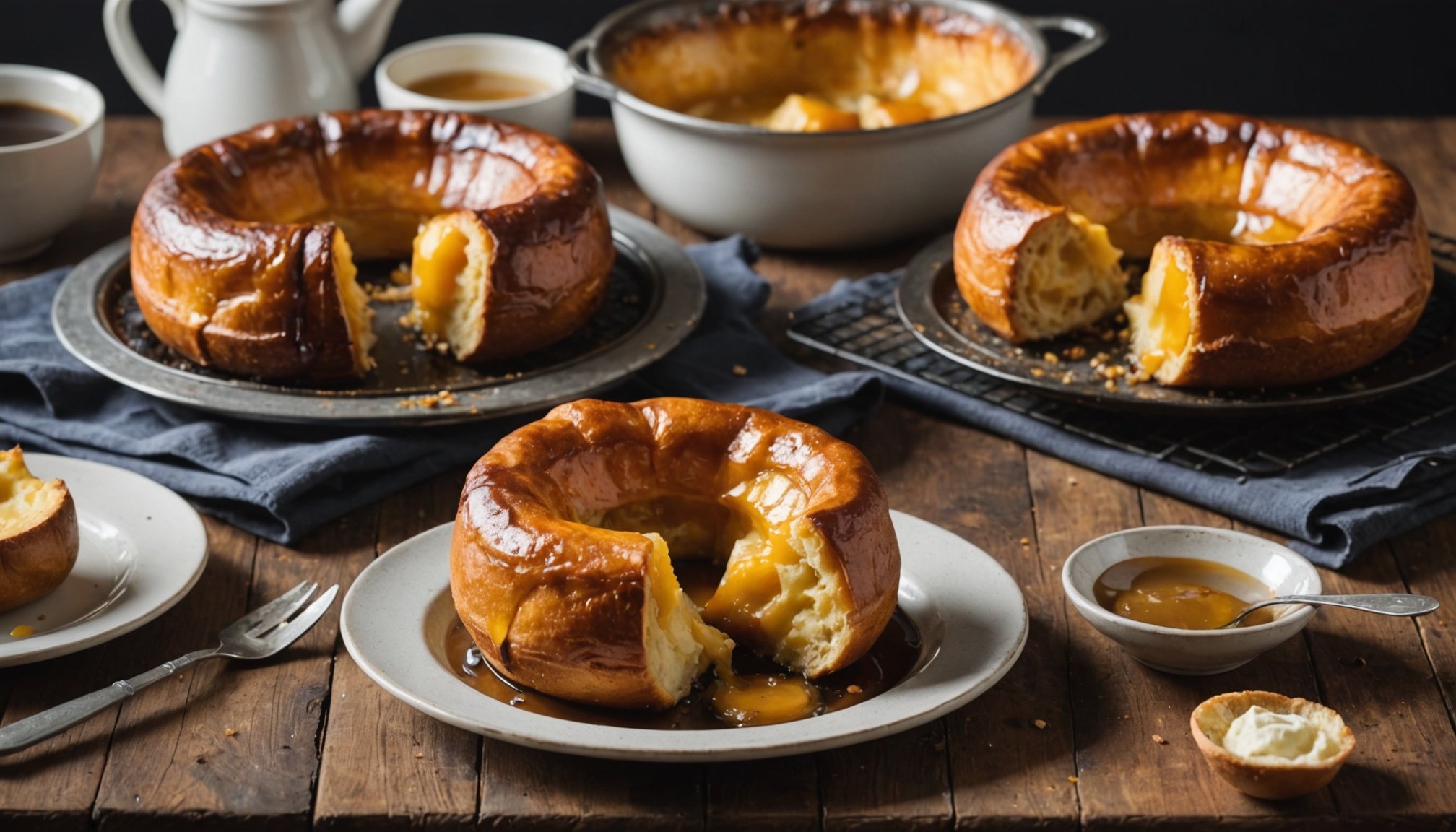Understanding Yorkshire Pudding
Originating from England, Yorkshire pudding has been a cherished part of British cuisine for centuries. This delicious dish traditionally accompanies a Sunday roast and exemplifies rustic charm. Its history traces back to the early 18th century when thrifty cooks used dripping fat from roasting meats to create a savvy starch side dish.
The variations of Yorkshire pudding reflect regional and familial preferences. While some families opt for a puffier, individual-sized treat, others favour a large, flat version that’s sliced into portions. These variations in Yorkshire pudding recipes can also manifest in cook times, oven temperatures, and pan types used, resulting in distinct looks and textures.
Also read : Mastering the Art of Creamy English Trifle with Sherry: Your Ultimate Guide!
Critical to achieving the dish’s trademark fluffiness are its commonly used ingredients: flour, eggs, and milk. The batter is straightforward, yet its precision is crucial—too much flour or insufficient whisking might result in a pudding that’s too dense or doesn’t rise well. Heat plays a significant role as well; a very hot oven ensures a crisp outer texture with a soft, airy interior. Understanding these basics allows a home cook or professional chef to bring a touch of British tradition to the table with their own touch of flair.
Key Ingredients for Fluffy Yorkshire Pudding
Creating the perfect Yorkshire pudding involves understanding the pivotal role of each ingredient. First, the type of flour is crucial. Using plain flour contributes to that classic airy texture. Avoiding self-raising flour ensures the rise comes from technique, not additives, maintaining an authentic taste.
Additional reading : Discover the Ultimate Recipe for a Luxuriously Creamy English Blancmange”
Eggs also play a vital role, acting as the binding agent and contributing to the pudding’s lift. Beaten well, they incorporate air, adding volume and a tender crumb. The balance of eggs can affect the firmness and overall height of the pudding, so precision is key.
On to milk—a subtle contributor to both flavour and consistency. Whole milk is typically preferred for its richer taste, but semi-skimmed can work if a lighter profile is desired. The liquid binds with the flour to form the batter while contributing to its smoothness.
Finally, seasoning is simple yet impactful. A pinch of salt enhances the flavour without overwhelming the delicate balance of ingredients. Experimenting with a dash of mustard powder or nutmeg can add a personal twist, but the classic approach keeps the taste traditional and timeless.
Mastering the Perfect Batter
Creating the perfect batter requires attention to detail and understanding of the process. Batter preparation is a critical step, beginning with precisely measuring your dry and wet ingredients. Accurate measurement ensures balance between the components, allowing for consistent texture and taste.
Understanding mixing techniques is essential. Gradually combine the ingredients to prevent lumps and ensure a smooth consistency. Avoid overmixing, as this can lead to a dense and chewy texture due to gluten development. A gentle fold is often preferable for delicate batters, maintaining the airy quality needed for fluffy results.
The resting time of the batter is another crucial factor. Allowing the batter to rest for around 15-30 minutes is optimal for achieving fluffiness. This resting period lets flour particles absorb the liquid, swelling for a tender and light texture. It also allows trapped air bubbles to escape, reducing unwanted density.
Avoid common mistakes to ensure success. Overmixing stands as the primary culprit of tough batters. Impatience during resting can also hinder the desired texture. Adopting these steps and understanding the science behind batter preparation enhances your cooking and elevates the final dish.
Techniques for Cooking Yorkshire Pudding
Creating the ideal Yorkshire pudding texture hinges on a fine balance of ingredients and techniques. One such technique is maintaining the appropriate oven temperature. Preheating the oven to around 220°C (428°F) ensures optimal rise and a delightfully crisp exterior. The high temperature activates the batter quickly, promoting steam production which is crucial for achieving maximum rise.
Another secret to a more flavourful Yorkshire pudding lies in the use of pan drippings. Utilizing warm pan drippings from a roasted meat enhances the savoury flavour and adds richness to the pudding. It serves as both a flavour enhancer and a technique to prevent the pudding from sticking to the pan. This combination results in a scrumptious, golden-brown finish.
Finally, the cooking time is essential for perfection. Typically, a 20-25 minute cook ensures that the pudding sets properly, avoiding sogginess. Different ovens may vary slightly, so observing the rise and colour can guide you.
- Target oven temperature: 220°C (428°F)
- Use warm pan drippings for flavour
- Cook for 20-25 minutes for optimal results
These methods, when meticulously followed, guarantee an exemplary Yorkshire pudding that is as delectable as it is visually appealing.
Troubleshooting and Tips for Success
Facing common problems in the kitchen is inevitable, but many of these can be easily solved with the right knowledge and techniques. When your dough sits flat, deflation might be the culprit. The primary cause can be overworking the mixture or a lack of proper resting time.
To rectify sogginess in a baked treat, ensure your oven is preheated correctly, and use dry ingredients. It’s also important to monitor cooking times closely to avoid creating issues.
Culinary experts share that achieving consistently fluffy results often requires a combination of technique and ingredient quality. One insider tip is to incorporate a pinch of salt into your dough; this can enhance the texture, making each bite delightfully airy.
Expert tips also suggest using substitutes such as almond flour instead of regular flour for better absorption and a lighter outcome. It’s crucial to measure your ingredients accurately and maintain even mixing without overdoing it. Regularly calibrating your equipment can prevent common mishaps and improve overall consistency.
Remember, experimenting with different techniques and adjustments can lead to discovering what works best in your culinary activities.
Serving Suggestions and Pairings
Yorkshire pudding, cherished for its versatility, can elevate a variety of main dishes. Traditionally an accompaniment to the Sunday roast, its airy texture contrasts beautifully with succulent meats like roast beef or lamb. Exploring different serving styles expands its appeal across menus.
Popular Pairings
Start with classic trifles—Yorkshire pudding served alongside a rich gravy adds a robust flavour dimension. The pudding can also be a delightful side to stews or casseroles, absorbing savoury sauces perfectly.
Serving Styles
Experiment with the presentation to enchant your guests. Consider using Yorkshire puddings as edible bowls for savoury fillings. Fill them with creamy mushroom ragout or spicy pork and apple stuffing for an unexpected twist. Mini Yorkshire puddings make delightful canapés when topped with smoked salmon or roasted vegetables.
Suggested Accompaniments
Boost your meal’s flavour profile with complementary sides and sauces. Tangy horseradish cream enhances beef pairings, while a zingy mint sauce pairs wonderfully with lamb. Traditional roasted veggies or a fresh, zesty cucumber salad balance the richness of the dish.
Incorporating these serving suggestions can transform a simple Yorkshire pudding into the star of your table.






